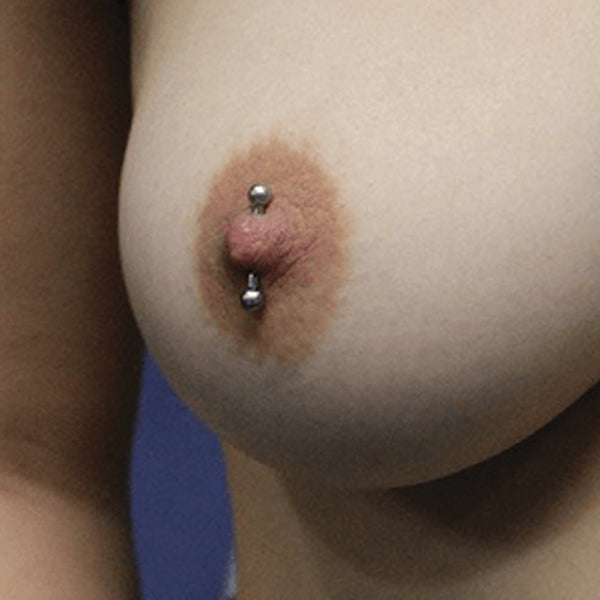Available nipple piercings
Our piercer offers nipple piercings to persons over the age of 18.

HORIZONTAL
Horizontal piercings are the most commonly requested piercing, these are placed placed through the nipple tissue, parallel to the ground, like all nipple piercings a horizontal piercing should be located at the nipples base, where the it meets the areola.
Healing time is betwen 9 and 12 months.

VERTICAL
Vertical nipple piercings are a little less commonly requested, they have slightly fewer jewelry options however still offer the benefits of increased sensitivity to the area and like their vertical counterparts can be great for giving the wearer that “is anyone else chilly” look.
Healing time is between 9 and 12 months.
Navel piercing FAQ
Nipples are sensitive, will this piercing hurt?
While every person is different, and the experience may vary we find that most people—women especially—are surprised that it is not as bad as they expected.
The best way to think of the pain associated with this piercing is as one really hard, quick bite. Or two if you are getting both pierced.
Can I get them both done at the same time?
We recommend that if you are planning on getting both done, to do them both at once.
The aftercare routine is no different between having one or both pierced at the same time, and as some people find that piercing hurts its easier to get it "over and done with"
Can you pierce inverted nipples?
Small or inverted nipples can almost always be pierced, and piercing inverted nipples almost always results in "fixing" the inverted nipple so that it is no longer inverted when erect.
However, we do not recommend piercing nipples that are so flat or inverted they do not come up even when tweaked or cold as the jewelry is more likely to migrate forward or grow out over time.
Can you lose sensation?
Your nipples will most likely become more sensitive after being pierced, not less.
If the loss of sensation were a serious risk, there simply wouldn’t be as many people getting it done.
The nerves in a nipple are spread out, there is not one single nerve that may be severed by a piercing.Some people do describe a slight loss of sensation as they become accustomed to their piercings over the years.
Meaning that their nipples are not as sensitive as they initially were directly after they were first pierced, and that they have returned to the same sensitivity level they were before being pierced.
For clients who do find that their sensitivity returns to the pre-piercing level and wish to regain that "just pierced" feeling, we often recommend inserting slightly thicker jewelry and stretching the size of the piercing a bit to bring back that initial hyper sensitivity.
Will they show through my clothing?
How visible your piercing is through clothing really depends upon what type of clothing and what type of jewelry you are wearing.
Padded bras hide most jewelry and barbells with smaller ends are less visible than thicker jewelry or circular jewelry.
Some people prefer to have their piercing peek through their clothing, for this we recommend slightly larger balls on barbells, or circular jewelry.
Can women still breast feed after getting their nipples pierced?
Nipples are comprised of multiple milk ducts, not just one central channel, so piercing your nipples in no way hiders your ability to breastfeed at a later date.
We do however recommend that you avoid getting pierced if you are currently nursing or think you may be pregnant, your piercings should be fully healed before the little one goes anywhere near them and we never recommend any body modification procedure whilst pregnant or breastfeeding.
How soon until I can go swimming?
With any fresh piercing we generally recommend you avoid swimming for the first month or two.
The degree of risk to your piercing is dependant to a degree on where you are swimming, saltwater and chlorine may be okay for your piercing, however, other bacteria in the water may be problematic.
If you do go swimming during the healing process, the most important thing to do is to make sure that you thoroughly clean your piercing afterward.
What to expect
Body piercings vary in healing times anywhere from 8 weeks to a several months depending on the
piercing site.
Everyone’s body is different so be patient and allow your body the time it needs to heal.
Initially there may be bleeding, or occasionally slight bruising around the piercing site.
Slight to moderate swelling can be expected.
The tissue around the piercing can become tender and slightly
red/pink during the first few weeks of healing.
A clear or light yellow discharge might occur off and on indefinitely. This discharge forms a crust which you can rinse off gently with warm water.
Do not touch or pick at your piercing and never rotate the jewelry while your piercing is healing!
What to do
Rinse your piercing twice daily (or as recommended by your piercer) in warm running water to soften and remove any crust that may have formed around your piercing.
Warm water helps keep the area clean as well as increasing circulation which is beneficial to healing.
After the warm water rinse, follow with Simple Care Spray or a Sterile Wound Wash Saline available at any pharmacy.
Spray directly on the piercing twice daily and leave your piercing
alone.
DO NOT make your own salt solution at home as this can impede healing.
We are not responsible for lost jewellery so please check your jewellery daily with freshly washed hands.
Threaded jewellery can loosen and fall off.
Playing with your jewellery not only increases your chances of complications during healing, but it may also result in the loosening of threaded ends and in turn
the loss of the piercing site so keep your hands away from your piercing as much as possible.
Ensure anything that comes into contact with your piercing such as clothing, bedding, towels etc. are
clean until your piercing is fully healed.
What not to do
Do not touch your piercing unless you are checking the threading. Do not allow anyone else to touch your piercing.
Never pick at or rotate your jewellery.
Do not use Q-Tips or cotton swabs or any other materials that may leave fibres behind.
Do not bandage your piercing. Refrain from wearing tight clothing.
Do not use antibacterial soaps, peroxide, rubbing alcohol, Bactine, antibiotic ointments (Polysporin)or other first aid products unless instructed to by your doctor.
Do not submerge your piercing in any bodies of water including bathtubs, lakes, oceans, hot tubs swimming pools, saunas etc. until it is fully healed.
Do not remove or change your jewellery for at least 8-12 weeks or as directed by your piercer.
Always check with your piercer as to suitable jewellery options for your particular piercing and anatomy and always be aware of the quality of the jewellery you are putting in your body.
Do not share jewellery. This puts you at risk for disease and/ or infection transmission.
Do not rely on the advice of friends, family or the internet. Your piercer knows what works best for their practices.
If your piercer is unavailable, or if you suspect complications or infection please contact your doctor.

